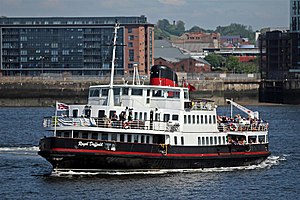
The Mersey Ferry is a ferry service operating on the River Mersey in north west England, between Liverpool to the east and Birkenhead and Wallasey on the Wirral Peninsula to the west. Ferries have been used on this route since at least the 12th century, and continue to be popular for both local people and visitors.

Birkenhead is a town in the Metropolitan Borough of Wirral, Merseyside, England; historically, until 1974, in Cheshire. It is on the Wirral Peninsula, along the south bank of the River Mersey, opposite the city of Liverpool. At the 2011 census, it had a population of 88,818.

Cammell Laird is a British shipbuilding company. It was formed from the merger of Laird Brothers of Birkenhead and Johnson Cammell & Co of Sheffield at the turn of the twentieth century. The company also built railway rolling stock until 1929, when that side of the business was separated and became part of the Metropolitan-Cammell Carriage & Wagon Company.
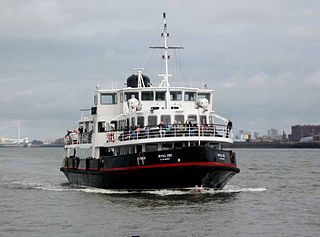
The MV Royal Iris of the Mersey is a Mersey Ferry in operation on the River Mersey, England. From launch in Devon in 1959 until a major refurbishment in 2001, she was named MV Mountwood.
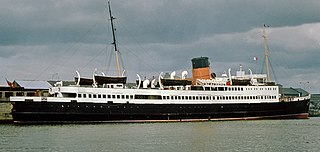
Turbine Steam Ship (RMS) Manxman was a passenger ferry launched from the Cammell Laird shipyard, Birkenhead, on 8 February 1955. She was the final vessel in a class of six similar ships, the Six Sisters, ordered by the Isle of Man Steam Packet Company, and was the second of the Company's ships to carry this name. She was withdrawn from service in 1982. Following a failed preservation attempt, and featuring in a music video in the process, the ship was broken up at Sunderland in 2012.

The MS Finbo Cargo is a roll-on/roll-off passenger ferry that was previously called the European Endeavour which was owned and operated by P&O Ferries until May 2019. Eckerö Line purchased the ship from P&O in 2019 and is expected to take delivery in June 2019 and renamed her MS Finbo Cargo.

MS Stena Baltica is a RoPax ferry, owned by Stena Line and planned to operate on the Baltic Sea between Nynäshamn, Sweden and Ventspils, Latvia. The ship previously operated on the Irish Sea, between Birkenhead and Belfast, as Stena Mersey.

The MVSnowdrop is a Mersey Ferry in operation on the River Mersey, England. From launch until a major refit in 2003, she was named MV Woodchurch.

MV Ben-my-Chree is a Ro-Pax vessel which was launched and entered service in 1998. The flagship of the Isle of Man Steam Packet Company, it primarily operates on the Douglas to Heysham route. The Royal New Zealand Navy multi-role vessel HMNZS Canterbury, based on Ben-my-Chree's design, entered service in 2007.

TSS (RMS) King Orry (IV) - the fourth vessel in the line's history to be so named - was the lead ship of the King Orry Class of passenger ferries and packet ships. More commonly referred to as the six sisters, they were built for the Isle of Man Steam Packet Company between 1946 & 1955 primarily to replace war-time losses. The company's previous King Orry was one of three company losses during Operation Dynamo - the evacuation of British and French troops from the port of Dunkirk during May 1940.

The MVRoyal Iris was a twin screw, diesel-electric, Mersey Ferry. The vessel was built by William Denny & Brothers of Dumbarton and launched in December 1950, costing £256,000.

MV Hrossey is a NorthLink Ferries vehicle and passenger ferry based in Aberdeen. With her sister ship, MV Hjaltland, she operates a daily ferry service between mainland Scotland and the northern archipelagos of Orkney and Shetland.
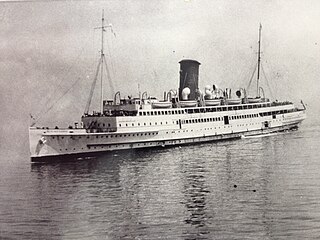
TSS (RMS) Ben-my-Chree (IV) No. 145304 – the fourth vessel in the company's history to be so named – was a passenger ferry operated by the Isle of Man Steam Packet Company between 1927 and 1965.

Burra Bra was a Manly ferry on Sydney Harbour that operated by the Port Jackson & Manly Steamship Company from 1908 until 1940, before being requisitioned by the Royal Australian Navy for use as an anti-submarine training vessel and target tow during World War II.
TSS (RMS) Manx Maid (II) was built by Cammell Laird at Birkenhead in 1962, and was the second ship in the Company's history to bear the name.
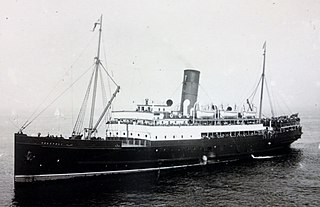
RMS Snaefell (III) – the third ship in the line's history to be so named – was a packet steamer operated by the Isle of Man Steam Packet Company from 1910 to 1914. She was then acquired by the Admiralty at the outbreak of the First World War, until she was torpedoed and sunk in the Mediterranean on 5 June 1918.

TSS (RMS) King Orry (III) – the third ship in the history of the Company to bear the name – was a passenger steamer which served with the Isle of Man Steam Packet Company, until she was sunk in the evacuation of Dunkirk in 1940.

The MV North Head was a ferry operated by the Port Jackson & Manly Steamship Company and its successors on the Manly service from 1913 until 1985.

MV Red Kestrel is a freight ferry built by Cammell Laird for Red Funnel for use on its Southampton to East Cowes service. She was launched on 19 February 2019 and entered service in May 2019 after completing her sea trials.

MV Sound of Soay is a car and passenger ferry, operated by Western Ferries on the upper Clyde between Gourock and Dunoon, Scotland.
